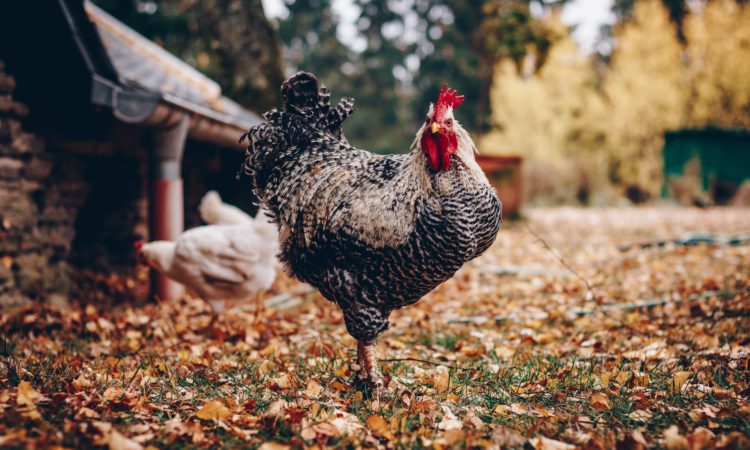What Chicken Breed is Right for You?
Oh, the choices! Buff Orpingtons, Crevecoeurs, Cuckoo Marans, Pearl-White Leghorns, Sebrights. Just the sounds of their names are so enticing – and poetic. Selecting your first flock of chickens or adding to your current flock is fun but so often mind-boggling. Ask friends or neighbors who have chickens, and they’ll certainly recommend their favorites: “Oh, so and so is the best.” or “I just love this one and that one.”
When we were deciding on our first chickens, we pored over websites and researched for months. We were split between the practical and the aesthetics. Because we live in the desert and high elevation climate of Utah, we needed a breed that could tolerant our frequent cold winters and hot summers. Having a friendly personality and being good layers were also important. And then there was my all-important criteria – being big enough that they could hold their own in a street fight, or maybe more appropriately barnyard rumble. Lastly, I admit, we liked pretty birds and soon become especially enamored with those with the funny feathered feet. Our final vote – a mix of chickens that all had their own unique advantages and unique looks!
This turned out to be an excellent choice as our flock does very well and is very healthy and happy. Hardy, pretty, sweet-tempered, and good layers, they were a joyful part of our outdoor family for many years. Since that first flock, we’ve added a variety of other breeds in the flock. Our current girls include Black Australorps, Ameraucanas, Golden Sexlinks, a Black Sexlink, White Leghorns, a Danish Brown Leghorn, Barred Plymouth Rocks, a Rhode Island Red, a Speckled Sussex, and our rooster is a beautiful Black Laced Silver Wyandotte.
So, when the time comes to makes the breed selection, here are a few factors we suggest you consider.
Weather:
Most chickens will thrive in moderate climates, but some are better suited for colder or warmer regions. Generally large, compact chickens, such as Plymouth Rocks and Wyandottes, do well because their bodies are better designed to retain heat. Additionally, chickens with smaller combs, such as pea or rose combs, tolerate long winters because their combs are less likely to suffer from frost bite. The feathered feet of these birds and other also make them good choices for colder climates. Brahmas and Cochins fall into this group. In a sense, they come with their own pair of Uggs!
On the other hand, longer and narrower chickens, including Anconas, Leghorns, and Minorcas, do a better job tolerating warmer temperatures. Such a tolerance makes sense given their Mediterranean roots – and their love of coops on high-end beach front property.
Temperament:
Australorps, Barred Rocks, Brahmas, Cochins, and Orpingtons are always the top contenders for the title of “Miss Congeniality” in both their interactions with both people and other chickens. Calm, gentle, and curious, they make great backyard flocks if you’re looking for chickens who are affectionate and family-oriented.
On the other hand, Hamburgs, Lakenvelders, La Fleches, Leghorns, and Sumatras lean toward being more high-strung and flighty, while Crevecoeurs and Malays have a reputation for being the thugs of the chicken coop.
Then again, remember that chickens have their individual personalities. Just because they’re suppose to be warm and cuddly or remote and flighty doesn’t mean they will be. Take the Speckled Sussex. Elissa describes her Puff as a real sweetheart, always looking for a little extra attention with her soft murmurs and eagerness to be cuddled on a knee. Our Speckles, though, well … we’ve nicknamed her the “Evil One. Trying to catch her is almost impossible, and, when we do, she’s not above pecking us to the point of drawing blood. Nonetheless, she is one of our favorites because she has such an independent spirit. (And she’s also very, very smart!)
We strongly recommend spending time with your chicks right from the start to help cultivate a good relationship and bring out the best of their personalities. Keep in mind, too, that some breeds, such as Silkies and Faverolles, tend to be clicky and not appreciate the cultural exchanges available in a mixed flock.
(Although some poultry experts believe that chickens are incapable of experiencing real affection, we heartily disagree!)
Eggs:
White eggs, brown eggs, colorful Easter eggs, big eggs, small eggs. And, then there’s productivity. Oh, the choices… again!
Let’s start with how many eggs you can expect. Most breeds of chickens start to lay when they’re around six months old with a few starting at eight months. These first pullet eggs are small, but they do give you a taste of what’s to come – unbelievably fresh eggs with the most brilliant orange yolks. (You’ll make lots of new friends who love you only for your eggs!) Hens are most productive in their first, second, and sometimes third years. We usually introduce new chicks to our flocks every two years just to ensure that we have a continuous supply of eggs and give our older hens a well-earned retirement.
Rhode Island Reds, Welsummers, New Hampshire’s, and Delaware are considered among the best layers, averaging about 5-6 eggs a week. Next come Aconas, Australorps, Crevecoeurs, Jersey Giants, Malays, and Transylvanian Naked Necks producing 3-4 eggs a week. (However, rumors in poultry circles have it that one Astrolop laid 364 eggs in 365 days – a possible world record?) And last but not least the Araucanas, Buttercups, Cochins, Hamburgs, Phoenixes, and Sultans – a little less ambitious in the egg business but still nice birds. Chickens are most productive in the spring and summer with fall and winter bringing a lull in productivity.
Making sure that your chickens are well cared for will also affect the number and quality of eggs that they produce. Calcium (oyster shells) and phosphorus (defluorinated rock phosphate) are essential for good strong egg shells.
Lots of hens lay white eggs, but if you’re looking for a little variety, here’s a list of possibilities:
Easter Eggs – Araucanas (blue) and Americanas (blue and green)
Dark Brown Eggs – Delawares and Marans
Reddish Brown Eggs – Barnvelders and Welsummers
Pinkish Brown Eggs – Faverolles and Plymouth Rocks
Light Brown Eggs – Polish and Sussex
Noise:
All chickens make noise, with hens tending to be less vocal than roosters. Laying an egg, warning flock mates of potential predators, or announcing a newly found worm are just a few reasons why chickens may have something to cluck, bawk, growl, or cackle about.
Not surprisingly, your good old most popular breeds are the least boisterous – Barred Rocks, Black Australorps, Brahmas, Buff Orpingtons, Cochins, and Jersey Giants, to name a few. Americanas and Araucanas are reported to also be the more silent type. If you’re living in close proximity of neighbors or just prefer a more sedate back or barn yard, these would probably be your best choices. Some birds, such as Cornishes and Cubalayas have the reputation of being more raucous.
Then again, there are always exceptions to the rule!
Space:
Whether your chickens will be confined to a coop, be free ranging, or find a balance between the two obviously depends on many factors, including the size of your property and local laws. Most breeds can easily adapt to any of those three options. However, there are some notable exceptions. Because they tend to be more active and flighty, Anconas, Buttercups, Cubalayas, Hamburgs, Malays, and Sumatras, for example, do not do well when confined compared to, say, Dominiques, New Hampshires, and Plymouth Rocks.
One option to consider for limited spaces is bantams. Weighing between one and two pounds, they come in a variety of breeds and produce delicious eggs – just a bit smaller than their full size counterparts. In our experience do not mix bantam size chickens with full size flock birds. There are seemed to be issues and it’s just easier to avoid this by choosing one or the other.
Looking for more information? Here are our recommendations….
The Old Farmer’s Almanac:
http://www.almanac.com/blog/raising-chickens/raising-chickens-101-choosing-breed
The American Livestock Breeds Conservancy/Pick-A-Chick: Chicken Breed Comparison: http://www.albc-usa.org/heritagechicken/chickencomparison.html

